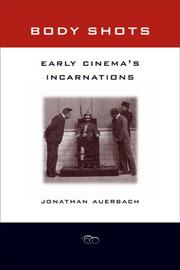| Listing 1 - 1 of 1 |
Sort by
|

ISBN: 1282772279 9786612772276 0520941195 1435611454 9780520941199 9781435611450 9781282772274 6612772271 9780520252592 0520252594 9780520252936 0520252934 Year: 2007 Publisher: Berkeley University of California Press
Abstract | Keywords | Export | Availability | Bookmark
 Loading...
Loading...Choose an application
- Reference Manager
- EndNote
- RefWorks (Direct export to RefWorks)
This original and compelling book places the body at the center of cinema's first decade of emergence and challenges the idea that for early audiences, the new medium's fascination rested on visual spectacle for its own sake. Instead, as Jonathan Auerbach argues, it was the human form in motion that most profoundly shaped early cinema. Situating his discussion in a political and historical context, Auerbach begins his analysis with films that reveal striking anxieties and preoccupations about persons on public display-both exceptional figures, such as 1896 presidential candidate William McKinley, and ordinary people caught by the movie camera in their daily routines. The result is a sharp, unique, and groundbreaking way to consider the turn-of-the-twentieth-century American incarnation of cinema itself.
Silent films --- Human body in motion pictures. --- Body, Human, in motion pictures --- Motion pictures --- History and criticism. --- 19th century american film history. --- 20th century american film history. --- american film. --- american fireman. --- bodies in public. --- bodies in space. --- cinema of attractions. --- cinema production. --- cinema. --- corporeal movement. --- early cinema. --- film history. --- film narrative. --- film studies. --- film. --- human form in motion. --- movie history. --- movie studies. --- movies. --- persons on public display. --- presidential candidate. --- self consciousness. --- visual art. --- visual spectacle. --- william mckinley.
| Listing 1 - 1 of 1 |
Sort by
|

 Search
Search Feedback
Feedback About UniCat
About UniCat  Help
Help News
News